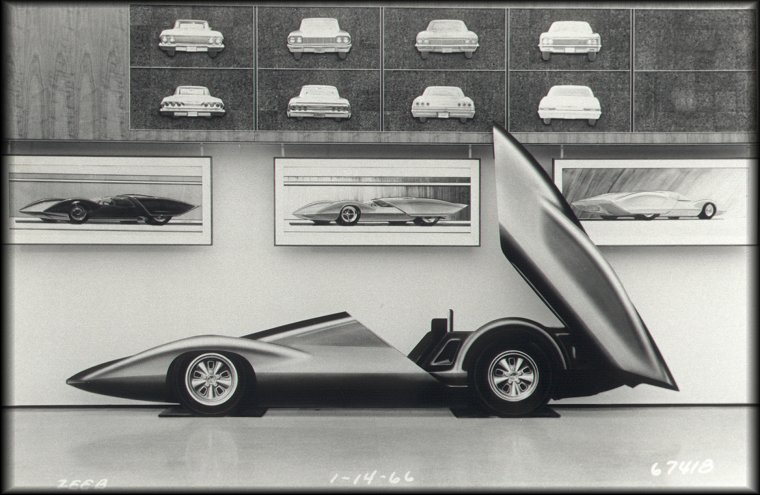

![]()
Astro-I Design Study
|
One of the wonderful things about life is just how unpredictable it is. On a recent outing to a newly opened Irish pub a few minutes from my home, I was introduced to a fellow who, like me, had a Corvair Corsa is his past. Over a mug of Guinness and shared memories of life in the Sixties, the conversation turned to the Internet, and the World Wide Web's wealth of classic car sites. "My brother-in-law publishes a Corvette magazine," he told me. "You really should meet him. He was involved in setting up the Corvette Museum in Bowling Green, Kentucky, and would be a good contact for you." A week later, I met Wayne Ellwood, Editorial Editor of Shark Quarterly, the magazine for C3 Corvette enthusiasts. Wayne offered me an opportunity to peruse his archives, in which he had photos and literature on Chevrolet's Corvair-related design study vehicles. It was an offer I couldn't refuse. |
|
|
While working with Shark Quarterly and the Corvette Museum, Wayne naturally developed contacts at General Motors. In March, 1995, he interviewed, for the Fall '95 edition of the magazine, Corvette/Corvair designer, Lawrence (Larry) Kiyoshi Shinoda. Shinoda, famous for designing such classics as the 1963 split-window Corvette Sting Ray, the Mako Shark prototype and the C3 series Corvette, was also a key figure in the design of the Corvair Monza GT and SS design studies (see the GT/SS section of this site). The GT and SS were the cars that so heavily influenced the style of the second generation Corvair. We have Larry to thank for its timeless good looks. |
|
Larry Shinoda in 1995 |
|
In the early part of his career, which lead to his becoming a key member of the Bill Mitchell design team at Chevrolet, Larry made his mark in racing in a 1924 Ford roadster, the car in which he won the first National Hot Rod Association (NHRA) Nationals at Great Bend, Kansas, in 1955. The previous year, he had scored his first major auto industry job with Ford, and moved from his native California to Detroit. In January of 1956, he joined Studebaker/Packard (just prior to its demise) and by September, he was hired by General Motors' head of design, Harley Earl, and began design work on the 1959 Chevrolet. Later, he went on to work on the 1960 and '61 wide track Pontiacs. Then Larry "got lucky," as he put it in an interview with Shark Quarterly, and in 1958, was reassigned to "special styling projects" by Bill Mitchell. "I think it mostly came about as a result of a drag race on the way home from work," he recalled, and went on to describe how he had "basically smoked" Mitchell in a stop light tournament. Shinoda was driving a '55 Ford, and Mitchell, a red Pontiac. A couple of weeks later, Mitchell went to visit him in the studio and asked if his Ford was supercharged. Shinoda told him it only had two 4-barrels, and Mitchell asked him to bring it in to the garage, so he could have a look at it. Thus began a relationship that would spawn many of Chevrolet's most exotic cars, including the original String Ray racer, the inspiration for the 1963 production Corvette. Shinoda's favorite among these, was the Corvair Monza GT. He maintained that many of the "lines" of the design saw their way to many other outstanding Chevrolet design creations, including the Aerovette. Let's have a look at some photographs from the Mitchell/Shinoda period. Below, a glimpse of a design exercise captured on film on January 14, 1966. In the foreground, the Corvair-powered Astro-I, contrasting sharply with the front and rear views of production 1963 through 1966 Chevrolets appearing at the top of the shot. |

|
If the Astro-I looks futuristic today, imagine its impact in 1966, as it started to take shape in the design studio. Designed to investigate the "visual potential of automobile aerodynamic characteristics," the Astro-I sought to combine beauty and low drag coefficient. Wind tunnel data of the day suggested a vehicle should be designed low to the ground, with a small frontal area and a high back. If these conditions were to be met, a conventional front-mounted engine was out of the question. Of course, at Chevrolet, the ideal engine was close at hand. Enter the Corvair flat-six. |
Click the road sign for more.
Select from the navigation bar!